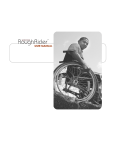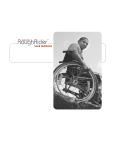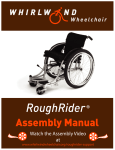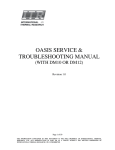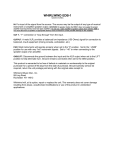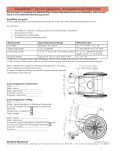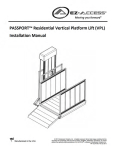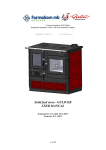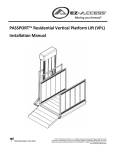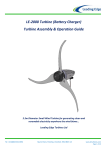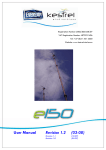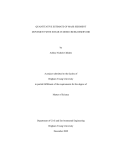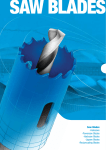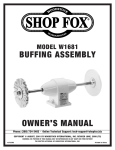Download RoughRider User Manual
Transcript
USER MANUAL Your RoughRider™ USER MANUAL USER MANUAL USER MANUAL The RoughRider wheelchair’s innovative design helps you ride more easily and safely (Figure 1.1): • Over very rough ground without tipping forward. • Over soft surfaces, without the front wheels getting stuck. • Down and across slopes, with minimal effort and much less risk of tipping. (Figure 1.1) The RoughRider is compact, lightweight, and has a comfortable seat. The RoughRider’s folding frame makes travel easy on buses and automobiles (Figure 1.2). The RoughRider was designed with few removable components to minimize the loss of parts. The RoughRider was also designed for easy repair and maintenance using commonly available parts and tools. (Figure 1.2) The RoughRider’s design is the culmination of ideas and innovations of wheelchair builders, users, and experts from around the world who promote the independence of wheelchair riders. www.whirlwindwheelchair.org page 1 of 57 USER MANUAL Who is the RoughRider for? USER MANUAL To avoid potential injury, the RoughRider should only be used by someone who can meet the USER MANUAL following criteria: USER MANUAL Pressure Management - The single most important criterion. If you have limited or no sensation (feeling) you must be able to manage the pressure on your body to use the RoughRider safely (e.g., proper techniques for self care, pressure relief, skin care). A pressure ulcer can form after only 20 minutes of sitting without pressure relief. You must always have an appropriate, high quality pressure relief cushion (and know how to care for it) to use with the RoughRider. Head and Trunk Control - The RoughRider’s sling-type backrest may not be suitable for you if you have weak or absent trunk muscles, as you may not have enough muscle support to maintain a desirable riding position. Using the RoughRider with inadequate trunk control could lead to the development of scoliosis (curvature of the spine). If you are not able to support your head independently, you should not use the RoughRider, as it does not provide any head support. Size and Fit – The RoughRider is designed for riders with hip widths between 31.5–48.5 cm* (12.5–19 in.), and an upper leg length longer than 40.7 cm (16 in.). The length measurement is taken while seated and measures from back of pelvis to back of lower leg. With some standard modifications however, the RoughRider may be suitable for riders outside of these ranges. See end of section for more information. *Seat widths may vary depending on manufacturer. RoughRider Specifications 355mm (14 in.), 400mm (15.7 in.), 440mm (17.4 in.), 480mm (19 in.) Seat Depth: 405mm (16 in.) Seat Height: 485mm (19 in.) at front of seat Seat Angle: 12 degrees Seat to Back Angle: 90 degrees 435mm (17 in.) standard, 380mm (15 in.) and 485mm (19 Back Height: in.) custom Footrest Height from Front of Seat: 255mm–375mm (10–14.75 in.) Rear Wheel Dimensions: 24 x 1.75 in. standard Rear Wheel Camber: 3 degrees Rear Wheel & Caster Barrel Bearings: 6201 (12mm ID x 32mm OD) Axles: 12mm; Class 8.8 hardness (Grade 5) Push Rim Diameter: 485mm (19 in.) Front Wheel Dimensions: 110mm (4.3 in.) diameter x 80mm (3.1 in.) width Front Wheel Bearings: Standard bicycle hub and bearing Overall Width: 229mm (9 in.) + Seat width Overall Length: Shortest 910mm (36 in.); longest 990mm (39 in.) Wheelbase (Front to Rear Axle): Shortest 480mm (19 in.); longest 560mm (22 in.) Rear Wheel Position Adjustment: 5 positions over 80mm (3 in.) Weight: 16.75 kg (37 lbs) RoughRider specifications: numbers are approximate and may vary depending on manufacturer. Effective Seat Widths: *seat fabric will be narrower than effective seat width page 2 www.whirlwindwheelchair.org Your RoughRider™ Basic Riding Skills Maintenance and Repair RoughRider™ Components Side Frame Back and Seat Upholstery Cushion Rear Wheel Push Rim X-Brace Wheel Lock Footrest Caster Barrel Caster Fork and Caster Wheel Upon receiving your RoughRider, please make a note of how the components are adjusted so that you can easily adjust them in the future. It is recommend that you write down the following critical measurements and refer to them when performing inspections or maintenance on your RoughRider: Seat Width Seat Height Footrest Height __________________cm __________________cm Right __________cm Left __________cm Whirlwind RoughRider™ User Manual (measured between inside edges of side frames) (measured from floor to front edge of seat) (measured from front edge of seat to back edge of foot plate) page 3 of 57 USER MANUAL RoughRider™ Features Long Wheelbase USER MANUAL USER MANUAL USER MANUAL Small diameter caster wheels fit under the footrests, resulting in a longer distance between the rear wheels and caster wheels without making the chair longer overall (Figure 1.3). The small wheels also allow you to maintain a low knee height, so that your knees can fit under tables. (Figure 1.3) What are the advantages of a longer wheelbase? • Prevents tipping (better forward stability) when traveling over uneven terrain, such as rocks or uneven dirt roads. • Easier to push because more weight is on the rear drive wheels, and less on your front caster wheels, which gives you better traction on uneven ground and makes it easier to roll straight on a side slope. Foldable X-Brace Why have a foldable X-brace? • Chair folds flat for easy storage and transport (Figure 1.4). If your chair does not fit under or behind the rear seat of a van or bus, you could be charged double or triple for transport. • Chair width can be easily changed by substituting a different size X-brace and upholstery. (Figure 1.4) page 4 www.whirlwindwheelchair.org Your RoughRider™ Basic Riding Skills Maintenance and Repair Pneumatic Rear Tires Most RoughRiders come with all terrain pneumatic tires (mid to heavy-weight) (Figure 1.5), that fit on standard wheel rims (24 x 1.75 in.) However, you might prefer light-weight tires and rims if you will be mostly riding indoors or in well-paved urban environments. (Figure 1.5) Why use pneumatic (air filled) rear tires? Because wider, sturdier, pneumatic tires provide better: • Shock absorption - air filled inner tubes absorb bumps better than standard hospital wheelchair tires that are made of solid rubber (Figure 1.6). • Durability - thicker, knobbier tires last longer on rough roads than standard wheelchair tires that are thin and have little tread. • Repair and replacement options - pneumatic tires are available wherever bicycle parts are sold and eliminate the need to search for special wheelchair tires. Solid rubber tire inserts may be an option to avoid punctures. (Figure 1.6) Wheel Locks “Parking Brakes” Stabilize your chair when it is stopped for easier and safer transfers, reaching, weight shifting, etc (Figure 1.7). Parking brakes should not be used to slow the chair because it will quickly wear down the tread of the tires. (Figure 1.7) “Zimbabwe” Caster Wheels (Figure 1.8) Why use “Zimbabwe” caster wheels? (Fig. 1.8) • The flexible rubber design provides a smooth ride over rough ground including cracks, stones, and other small obstacles. • The wide wheel “floats” over soft ground without getting stuck. • The V-tire profile reduces the sticky contact area of the tire so that it swivels easily on hard surfaces. Whirlwind RoughRider™ User Manual page 5 of 57 USER MANUAL Adjustable Rear Wheel Position USER MANUAL The RoughRider’s rear wheels have five positions. USER MANUAL Why have an adjustable rear wheel position? (Figure 1.9) An adjustable rear wheel position optimizes stability and performance for riders of differing abilities. USER MANUAL (Figure 1.9) With your rear wheels further forward: • Your chair will be easier to push because there is less weight on the front wheels. • Your chair will resist turning downhill on a side slope. • It will be easier to go over obstacles. • It will be easier to perform wheelies. With your rear wheels further back the chair will be less likely to tip backward. Start with the rear wheel in a position that feels secure to you. As your skill level increases with practice, the wheel position can be adjusted forward. Your Cushion If you have limited feeling in your buttocks, you should use a high quality foam cushion that is highly resilient (Figure 1.10). If you do not use a suitable cushion you are likely to develop a pressure sore. You should also perform regular pressure relieving exercises (see the Basic Riding Skills section for more instruction and information about limited feeling). A cushion can also make you feel more comfortable and can promote good posture. If you use a cushion, make sure your footrests are well adjusted so that your weight is evenly distributed on the cushion. page 6 (Figure 1.10) www.whirlwindwheelchair.org Your RoughRider™ Basic Riding Skills Maintenance and Repair Seat Angle The RoughRider was designed with 12 degrees of seat tilt (Figure 1.11). Why does the RoughRider have seat tilt? • Seat tilt makes sitting feel more natural and comfortable; the back-tilted position helps keep your trunk upright. • Seat tilt helps you resist falling forward out of the chair (e.g. when you are stopped suddenly by a bump). (Figure 1.11) Standard chair with little seat tilt Rider slumps forward and uses effort to sit. RoughRider with 12 degrees seat tilt Rider can reach farther back to push and can sit upright with less effort. Cambered Rear Wheels Cambered wheels tilt inward at the top of the wheel and outward at the bottom. The RoughRider has approximately 3 degrees of camber (Figure 1.12). Why have cambered wheels? • More stability side to side because the chair is wider at the bottom. • Easier to push the push rims because they are in line with your shoulders,closer to you, and angle outwards slightly. (Figure 1.12) Footrests The RoughRider’s footrests: • Are adjustable to accommodate users of different heights. • Fold out of the way for easier transfer (Figure 1.13). (Figure 1.13) Whirlwind RoughRider™ User Manual page 7 of 57 USER MANUAL USER MANUAL Common Modifications USER MANUAL USER MANUAL For Shorter Riders Shorter Seat Depth - If your upper legs are shorter than 40.7mm (16 in.), as measured from back of pelvis to back of lower leg, you can shorten the effective seat length by: • Asking the manufacturer (or a local metalworker) to shorten the seat tubes at the front and to make custom seat fabric to fit the new sized tubes; • Adding foam behind your back (Figure 1.14) so that you are sitting further forward (you may also want to move your rear wheels forward). (Figure 1.14) Shorter Back Height – Some manufactures may be able to customize the back height for you, if you prefer a shorter back height (Figure 1.15). (Figure 1.15) For Taller Riders If you are taller than 1.8m (6 ft.), you may need to make some modifications to make the chair fit better. This is especially important if you do not have full feeling in your body. In order to bear more weight under your thighs and less on your buttocks to prevent pressure sores, you can: • Adjust footrests to their lowest position. • Add dense foam under your normal cushion to lift you up, if your thighs are still not bearing weight (Figure 1.16). • Adjust your wheel position backward to stabilize your higher center of gravity. • Ask your manufacturer (or local metalworker) to make a higher backrest for you (Figure 1.17). A higher backrest may be more comfortable and support you better. (Figure 1.16) (Figure 1.17) page 8 www.whirlwindwheelchair.org Your RoughRider™ Basic Riding Skills Maintenance and Repair Optimal Riding for Amputees If you do not have legs, you may want to: • Move your rear wheels back to prevent yourself from tipping backward. • Remove the footrest(s) to minimize the weight of the chair, unless you use the footrests to carry loads or get in and out of the chair (Figure 1.18). (Figure 1.18) Calf Strap and Lap Belt You may want to add a calf strap to your RoughRider to keep your feet from slipping backward off the footrests (Figure 1.19). You can add a calf strap by wrapping a piece of material, such as webbing or heavy cloth, around the footrest tubes. (Figure 1.19) A lap belt may be useful to improve your control and keep your buttocks seated in the wheelchair. A lap belt can also help you feel more secure when riding your wheelchair. You can add a lap belt by attaching two strips of soft material, such as webbing, to the guide tubes (the inner curved tube on side frame) or to the back tubes and connecting the strips together with a buckle. Prevent areas of high pressure: It is very important when using both the lap belt and the calf strap to prevent the strap material from creating areas of high pressure. If you use a calf strap or lap belt make sure to routinely check the skin of your lap and the back of your legs and feet for signs of pressure sores. Refer to the Basic Riding Skills section for more instruction and information about limited feeling and skin checks. Whirlwind RoughRider™ User Manual page 9 of 57 USER MANUAL USER MANUAL Know Your Capabilities and Limits USER MANUAL The first step in learning how to ride your RoughRider wheelchair is to know its capabilities and limitations. To avoid injury, you also need to know your own capabilities and limitations. This knowledge will help you decide what you can do on your own and when you will need to ask for help. Get a Helper USER MANUAL Find someone who can help prevent you from falling or tipping over while you practice riding in your new RoughRider. It is recommended that your helper be with you at all times while you practice. (Figure 2.1) Have your helper hold a strap under the push handles The helper should stand where he/she can catch you or the chair and stop you from falling. The safest way this can be done is to have your helper hold a strap or rope looped under the push handles (Figure 2.1). This configuration minimizes the stress on the helper’s back, should he or she need to catch your chair. Wear a Safety Helmet Until you are experienced in using your wheelchair, we recommend that you wear a safety helmet (Figure 2.2). The best helmets will protect the back portion of your head, but do not restrict your vision. (Figure 2.2) Lock Your Wheels Why should you lock your wheels? Locking your wheels, so they can't move easily, makes it easier and safer to reach, stretch, and bend over. Make sure the tires are fully inflated and the brakes are adjusted to hold the wheels tightly. 1. (Figure 2.3) Unlocke d 2. 3. Locked How to lock your wheels: • Grab the wheel lock lever. • Pull the level up and all the way back (if the wheel locks are adjusted correctly, the brakes should push in a bit on the tires. If the wheels are properly locked, it will be very difficult, if not impossible, for the wheels to roll. • To unlock the wheels, push slightly out and then down on the lever (See Figure 2.3). www.whirlwindwheelchair.org Page 11 of 57 USER MANUAL USER MANUAL Shifting your Weight USER MANUAL It is important for you to know how far you can lean forward in your chair without tipping it over or falling out of it. You must learn how far you can lean while still being able to return to an upright MANUAL sitting position. Try the exercises in Figure 2.4 with your helper on hand to assistUSER you and keep you from falling: (Figure 2.4) 1. Lean Forward 2. Lean Backward 3. Lean Sideways Why lean forward? Lean forward to prevent tipping backward when you go: • Up hills/ramps. • Over curbs or up stairs. • Over obstacles (such as thresholds). • Down steps/curbs, in a backward position. Leaning forward when going uphill (Figure 2.5) (Figure 2.5) Why lean backward? Lean backward to prevent falling forward or tipping forward when you go: • Downhill (Figure 2.6). • Down steps. • Over curbs. Leaning backward also distributes more weight on the rear drive wheels, and less on your front caster wheels, which: • Gives you better traction on uneven ground. • Makes it easier to roll straight on a side slope. (Figure 2.6) Leaning back when going downhill page 12 www.whirlwindwheelchair.org Your RoughRider™ Basic Riding Skills Maintenance and Repair Why lean sideways? Lean sideways to prevent you and your chair from tipping over sideways when you: •1. Travel across the side of a slope. • Turn on a hill or ramp. Leaning sideways when going across a hill (Figure 2.7) (Figure 2.7) 1. Whirlwind RoughRider™ User Manual To help you learn how steep a slope (up/down/sideways) you can handle without tipping over, practice on slopes and uneven terrain with someone who will help keep you from falling. Practicing with a helper will give you experience in knowing when you will need help in the future. page 13 of 57 USER MANUAL Pressure Relief This section is for riders who: • Do not have full feeling in their bodies, or • Have poor blood circulation in their lower body, or • Have a history of pressure sores, or • Are at risk of developing a pressure sore. Why is pressure relief important? • A pressure sore can develop in as little as 20 minutes if you have been sitting on the wrong surface. • Pressure sores can develop on any part of the body. • Pressure sores can result in infections and complications that are among the most common causes of death for wheelchair users worldwide. • Factors that contribute to the development of pressure sores include prolonged, unrelieved pressure over bony areas of the body, shear force, heat, moisture, friction, and trauma. USER MANUAL USER MANUAL USER MANUAL Stage 4 Pressure Sore. At Stage 4, the sore extends into muscle, tendon, or even the bone. People with full feeling in their buttocks and legs frequently adjust their sitting position to relieve the discomfort that can result from pressure after sitting only a few minutes in one position. If you do not have full feeling in your buttocks and legs, it is important that you shift your weight while riding, so that you are not seated in the same position for too long. When you are seated, your pelvic bones put pressure on the muscles, tissues, and skin underneath them. Skin requires a constant flow of blood, and when too much pressure is placed on the skin, for example, when a person is seated in the same position for too long, the blood cannot flow to the skin and without blood the skin can die. This causes pressure sores which can take a very long time to heal and can even result in death. An infection very similar to a pressure sore can also develop from a cut or scratch that hasn’t been properly cared for and is in an area of high sitting or lying pressure. It is very important to take measures to prevent pressure sores. page 14 www.whirlwindwheelchair.org Your RoughRider™ Basic Riding Skills Maintenance and Repair How to Prevent a Pressure Sore Use a pressure relief cushion. If you have limited feeling in your buttocks, you should use a good quality cushion made from firm foam that is highly resilient and springs back when compressed. Be sure to replace the cushion when it starts to show signs of wear— signs of wear indicate that your cushion is not relieving sitting pressure as well as it should. Do pressure relief exercises. Lift your weight off your seat for 10-60 seconds at least once every 10-20 minutes (see following pages for how to do pressure relief exercises). If you have poor circulation and/or decreased feeling in your legs and buttocks, you should do longer and more frequent weight shifts; if you have feeling in your legs and buttocks and/or you are able to move around while sitting, you can do shorter weight-shifts. Regardless of your current physical capabilities, if you have had pressure sores in the past, you should perform more frequent and longer weight shifts. You should also shift position at least every 2 hours while in bed, and make sure your skin is kept clean and dry. Do skin checks twice each day (once in the morning and once at night). You can use a mirror to inspect areas you cannot easily see. If you are not able to see all areas of your skin, you may need to have a friend or family member check your skin for you. Examine your skin, especially on or around bony areas, looking for red or dark areas if you are light-skinned, or light, dry, flaky or ashy areas if you are darker-skinned. Discoloration should go away within 30 minutes after pressure has been released. Other signs of a pressure sore are skin that is warmer than normal and a hardening under the skin. Good Nutrition. You can help keep your skin healthy if you eat a well balanced diet and drink plenty of water to stay hydrated. If you see signs that pressure sore damage to the skin has already occurred, KEEP YOUR WEIGHT OFF THE AREA AND SEEK TREATMENT IMMEDIATELY. Whirlwind RoughRider™ User Manual page 15 of 57 USER MANUAL USER MANUAL Pressure Relief Techniques USER MANUAL USER MANUAL Remember: Shift your weight at least every 10-20 minutes. Each weight shift should last from 10 to 60 seconds. Push-Up If you have good strength in your arms, you can do a push-up by putting your hands on the wheels or push rims and then pushing up until your buttocks are off the cushion (Figure 2.8). Forward Weight Shifts Lean forward so your body rests on your knees and the weight is lifted off your buttocks (Figure 2.9a). You can also try putting your feet on the ground (lock your brakes first!) to allow you to lean even farther forward and take more weight off your buttocks (Figure 2.9b). If you find that when you lean forward you cannot sit back up without assistance try one of these alternate techniques. Figure 2.8 Figure 2.9a Figure 2.9b Figure 2.10 Reach back and hold on to or hook your wrists around the back posts before leaning forward (Figure 2.10). page 16 www.whirlwindwheelchair.org Your RoughRider™ Make loops by sewing or tying pieces of webbing, strong cloth or soft, thick rope (about 30cm or 12" long) to make a circle. Hook one loop over each push handle, and hook your wrists through the loops before you lower your chest down to your lap. With practice, you might be able to pull yourself back up to sitting (Figure 2.11). Lean forward and rest your arms and upper body on a table or desk (Figure 2.12). If you choose to use this technique, you should check or have someone else check to make sure that your weight really is off your buttocks. It should be possible for you or the other person to fit a hand between your buttocks and the cushion of your chair without too much effort. Side-to-Side Weight Shifts Do this once on each side. Get next to a horizontal surface such as a desk, table, bed or other surface which is low enough for you to lean on. Rest your forearm and hand on the surface and lean on it. Then push with your other hand against the opposite side wheel/push rim so you lean farther (Figure 2.13). This will lift your buttocks up off the seat slightly. OR, put your hands on the wheels/push rims and lean to each side, lifting your buttocks off the surface first on one side, and then on the other, OR, just lean as far as possible to either side (Figure 2.14). Whirlwind RoughRider™ User Manual Basic Riding Skills Maintenance and Repair (Figure 2.11) extension straps (Figure 2.12) lean forward on a table (Figure 2.13) Lean on table and push up (Figure 2.14) OR, just lean to each side page 17 of 57 USER MANUAL Leaning Back Weight Shifts You can relieve pressure if you are able to lean back far enough to lift your buttocks up off the seat, as shown in Figure 2.15. If you can wheelie safely, do so with your back to a chair, bed, or couch. Tip your chair back so your push handles are resting on the support (Figure 2.16). This will take the weight off your buttocks. When finished, lean forward while you pull back on your wheels to tip your chair upright again. If you can’t wheelie, have someone help you tip your chair back onto a chair, bed, or sofa (Figure 2.17). The easiest way is for a helper to sit on the chair/bed/sofa and tip you back until your push handles are resting on the helper's lap. page 18 USER2.15) MANUAL (Figure Lean back USER MANUAL USER MANUAL (Figure 2.16) Lean back and rest on a chair (Figure 2.17) OR, get a helper to tip you back on a chair www.whirlwindwheelchair.org Your RoughRider™ Basic Riding Skills Maintenance and Repair Moving Around On flat, smooth ground the best way to push your chair is by using the push rims. If you need more power on hills, ramps, or uneven ground, you can push on the tires or on the tires and push rims together. Experiment with other techniques as you get used to your RoughRider. Pushing Forward 1. (Figure 2.18) 1. Grab the push rims with your thumbs along the inside top edge of the push rim, with your fingers wrapping around the push rim from the outside (Figure 2.18). 2. If you can’t grasp the push rims, you can push against them with the heels of your hands. Pushing partly on the tires can help (Figure 2.19). 2. (Figure 2.19) Gloves can protect your hands and improve your grip. You can also wrap inner tubes around the push rims for better grip. Rubber band material made for slingshots also provides good grip. If you don’t have gloves, you can try wrapping cloth, strong tape or a piece of inner tube around the palm of your hand. This may help you get a better grip making it easier to push the chair. Pushing Uphill When going up a slope, you may roll backward when you take your hands off the push rims to take another stroke. To avoid rolling backward, you can alternate hands, so that you are always holding one push rim while your other hand is moving back for another stroke (Figure 2.20). You should also be leaning forward when you are going uphill. Sometimes it is easier to climb a hill by pushing backward. Another technique (especially useful on steep slopes) is to traverse the slope, pushing your RoughRider across the slope at an angle rather than straight up. Whirlwind RoughRider™ User Manual (Figure 2.20) page 19 of 57 USER MANUAL Riding Techniques USER MANUAL USER MANUAL USER MANUAL Wheelies Performing a wheelie lifts your front casters off the ground. Why lift your front casters off the ground? Lifting your front casters off the ground can help you get over obstacles like curbs, thresholds, potholes, and rocky ground. Sometimes a wheelie will make it easier to go down ramps or steep hills (Figure 2.21). (Figure 2.22) How to wheelie: (Figure 2.21) Try to practice on soft ground or on a mat or thick rug. • Roll backward, then reach back on push rims and • Push forward while you lean backward. • A helper can keep your chair from tipping backward and also make sure you don’t fall forward when you come back down from the wheelie (See Figure 2.22). Roll backward Push forward and lean backward Your helper (Figure 2.22) Find your balance point Once you know how to wheelie, practice finding the point where you can balance on your rear wheels. Get a helper to tip the chair back while you are holding your wheels still. Once you feel comfortable holding the wheels, have your helper let go while you try to maintain your balance (pushing forward tips you back, pushing back tips you forward as in Figure 2.23). page 20 (Figure 2.23) www.whirlwindwheelchair.org Your RoughRider™ Basic Riding Skills Maintenance and Repair Curbs Going down curbs: If you have enough trunk control, your RoughRider should allow you to go forward down a curb (18cm / 7 in. or less). To practice, lean as far back as you safely can, then ease yourself slowly forward over the curb with a helper to catch you. You control your speed by holding onto the push rims as in Figure 2.24. (Figure 2.24) Going up smaller curbs: If you have enough trunk control and you can wheelie, you should be able to go forward up a small curb. To practice, put your casters up against the edge of the curb, then pop them up and roll forward so they are on top of the curb. Then grab your push rims behind you, lean forward and push until you are over the curb as in Figure 2.25. (Figure 2.25) If you aren’t able to get up a curb this way, try pulling on something like a sign post or a tree (Figure 2.26). (Figure 2.26) Whirlwind RoughRider™ User Manual page 21 of 57 USER MANUAL USER MANUAL Going up larger curbs in motion (Advanced) With a lot of practice you may be able to wheelie while rolling towards a curb and the speed will USER MANUAL make it easier to get up the curb. With a little more speed you will be able to climb higher curbs. 1. 2. USER MANUAL 3. 4. (Figure 2.27) Practice going up curbs in motion: Once you are comfortable performing wheelies in place, • Draw a line on the ground in front of your RoughRider. • Back up about 1m (3 ft.). • Roll your RoughRider quickly towards the line and wheelie just before your front wheels touch the line. • Once you can wheelie easily without touching the line, try doing the same thing with a small curb/threshold (7cm / 3in.) in place of the line (Figure 2.27). You will probably hit the curb hard with your footrests or casters a few times, and you might fall forward out of the wheelchair if you are not careful. • Once you are able to get your casters up on top of the curb you should be able to roll your rear wheels up too. Falling and Tipping Practice “falling” with a helper so you will know how to protect yourself if you ever fall accidentally. Try to practice on soft ground (sand or grass) or on a mat or thick rug if you have one. No matter what direction you are falling, it is usually safer not to catch yourself by putting your hand out since you can easily break your hand or wrist. Prevent your head from hitting the ground if you are falling backward (Figure 2.28): • Lean forward and bend your neck so your chin touches your chest. • Grab the seat tubes under your knees and pull your torso forward to keep your head from hitting the ground. Chin to chest Grab seat tubes Keep head from hitting the ground (Figure 2.28) page 22 www.whirlwindwheelchair.org Your RoughRider™ Basic Riding Skills Maintenance and Repair To prevent injury if you are falling forward (Figure 2.29): • Bend forward. • Tuck your chin into your chest. • Wrap your arms around your head to protect it. (Figure 2.29) To prevent injury if you are falling sideways (Figure 2.30): • Lean away from the side to which you are falling. • Hold onto the up side of your chair to keep your buttocks in the chair and keep your hip from hitting the ground first. • Allow your arm or shoulder (not your wrist) to take the impact. Roll onto elbow or shoulder Do not fall onto wrist (Figure 2.30) 1. Whirlwind RoughRider™ User Manual What to do after you fall: • Make sure you aren’t injured. • Make sure the moving parts of your RoughRider are where they are supposed to be and nothing is broken. Adjust anything that you can. • Put the chair in a secure position sideways to the slope if you are on a ramp or hill and lock the wheels before transferring back into the chair. See Transfers section for how to transfer into your RoughRider from the floor. page 23 of 57 USER MANUAL USER MANUAL Transfers: Getting in and out of your USER MANUAL RoughRider™ USER MANUAL Practice to figure out the best way for you to get in and out of your RoughRider. These are just suggestions for how it might work. While you are learning, you should always have a helper nearby. Practice on a soft surface to avoid injuring yourself if you fall. The basics For most people, it is best to have the wheelchair at a 90 degree angle (Figure 2.31) to whatever surface you are transferring to or from. Lock your wheels before attempting to transfer. This will keep the wheelchair from moving during your transfer so you won’t fall. (Figure 2.31) 90 degrees page 24 If you are able to use your legs to support some of your weight, or if someone is helping you to transfer, you may want to fold your footrests out of the way. If you are not able to use your legs, you might want to leave your footrests in place to help support your feet during the transfer. www.whirlwindwheelchair.org Your RoughRider™ Basic Riding Skills Maintenance and Repair Transferring out of your RoughRider Figure out where you want your legs to be. If you can use your legs to hold some of your weight, you will probably want to keep them in front of and underneath you so you can stand up and turn in the direction you need to go. If you can’t use your legs to hold some of your weight, you might want to move your feet over so they are in front of where you are transferring to so you won’t have to drag them when you move your body (Figure 2.32a). Push up with your hands/arms (push against the wheel, the side-frame or the seat cushion) to lift your buttocks and move yourself forward to the edge of your seat (Figure 2.32b). Get your hands set: Put one hand on the far edge of the seat you are moving TO. Keep your other hand on the wheelchair you are moving FROM (Figure 2.32c). Using both hands to lift your body up, swing yourself over your wheel and onto the other chair (Figure 2.32d). If you land in a bad position, readjust yourself (Figure 2.32e). Whirlwind RoughRider™ User Manual (Figure 2.32a) Move your feet first. (Figure 2.32b) Scoot yourself forward to the edge of the seat. (Figure 2.32c) Get your hands set (Figure 2.32d) Lift up and swing over (Figure 2.32e) Readjust page 25 of 57 USER MANUAL Transferring into your RoughRider USER MANUAL USER MANUAL USER MANUAL 1. Adjust your legs 2. Get your hands set 3. Lean forward, lift up and swing over 4. Readjust Transferring from your RoughRider to the floor It is easiest to transfer to or from the floor if you have a support other than your chair to hold onto, such as another chair, bench, step, or bed. Be sure to lock your wheels. (Figure 2.33a) Get set (Figure 2.33b) Push Up and move forward (Figure 2.33c) Lower yourself (Figure 2.33d) Move onto the floor page 26 Put your chair across from the support with enough room for your body to fit between your chair and the support. Put one hand on the support surface. Put the other hand on your RoughRider cushion, side frame or wheel to push up and off (Figure 2.33a). Push up with your hands to lift your buttocks off your wheelchair seat and move yourself towards the edge of your wheelchair seat (Figure 2.33b). Keep supporting yourself with your hands as you lower yourself towards the footrests (Figure 2.33c). Once you are sitting on the footrests, you can move your buttocks off the footrests and onto the floor (Figure 2.33d). www.whirlwindwheelchair.org Your RoughRider™ Basic Riding Skills Maintenance and Repair Transferring to your RoughRider from the floor (Figure 2.34a) Get set Lock your wheels and put your RoughRider next to the support, with enough room between them for your body (Figure 2.34a). (Figure 2.34b) Get onto footrests (Figure 2.34c) Push up Lean forward and lift your buttocks up by either pushing down on the seat as shown in the picture or by pulling up using the support surface or the backrest tubes of the wheelchair until you are sitting on the footrests (Figure 2.34b). Lean forward and push as shown in the picture or pull on both the support surface and your RoughRider seat or frame to lift yourself up to the seat (Figure 2.34c). (Figure 2.34d) Slide into your seat (Figure 2.34d). (Figure 2.34e) Whirlwind RoughRider™ User Manual Adjust your position (Figure 2.34e). page 27 of 57 USER MANUAL USER MANUAL ™ Traveling with your RoughRider USER MANUAL Folding the RoughRider USER MANUAL 1. Flip the footrests up against the side frames (Figure 2.35a). (Figure 2.35a) 2. Pull up on the seat fabric until the chair sides come together (Figure 2.35b). (Figure 2.35b) 3. It may be helpful to have a piece of rope or cord, an old inner tube, a strap, a strip of cloth, or an elastic shock cord to tie around the side frames to hold them together so the chair will stay folded when it is picked up (Figure 2.35c). (Figure 2.35c) page 28 www.whirlwindwheelchair.org Your RoughRider™ Basic Riding Skills Maintenance and Repair Riding Public Transportation / Buses How to ride: The type of bus will determine how you ride the bus. To get on the bus, enlist two or more helpers to carry you on board OR drag yourself up the stairs. Your chair can be put in the back of the bus or on the roof of the bus. Even if it is possible to ride the bus in your chair, it is better to sit in the bus seat if you can because it is usually safer. Keep your chair cushion with you at all times to prevent loss. A wheelchair rider in Nicaragua gets three helpers to lift her and her RoughRider in through the back of the bus. She has to tell them what part of her chair they should grip to pick her up: “The push handles and side frame. Not by the rear wheels or I’ll end up on my head!” “Wheelchair riders always have the right to use public transportation. We also have the responsibility to help make public transport more accessible. The more we ride, as difficult as it may be, the sooner public transportation will be truly accessible.” -Ralf Hotchkiss For information about how to help make buses and transportation systems more accessible, contact: Access Exchange International www.globalride-sf.org 112 San Pablo Avenue San Francisco, CA 94127-1536 USA (415) 661-6355 Whirlwind RoughRider™ User Manual page 29 of 57 USER MANUAL USER MANUAL Maintenance and Repair USER MANUAL USER MANUAL Routine maintenance can: • Prevent breakdowns and excessive wear making your chair last longer, go farther, and cost less to repair. • Prevent injuries or long term damage to your muscles that result from sudden failures. • Make your chair more comfortable and easier to use. Some basic maintenance and repairs are explained in this section so that you will be able to keep your RoughRider rolling as long as possible. A bicycle mechanic may be able to help you with both maintenance and repair if needed. It is a good idea to get to know a good mechanic who is close to where you live. Explain to the mechanic how you use your wheelchair, and use the information in this manual to help your mechanic understand how a wheelchair works. After reading this section of the manual it is a good idea to discuss anything that is not clear with the manufacturer, distributor, or an experienced Whirlwind RoughRider user. They should be able to show you how to perform different maintenance and repair tasks. In an emergency situation, you may be able to: • Drive the wheelchair with a flat or completely missing tire by leaning your weight away from the missing/flat tire though this will quickly damage the wheel rim (Figure 3.1). • Drive the wheelchair without one of the front casters by leaning your weight away from the missing wheel (Figure 3.2). Fig. 3.1 Fig. 3.2 It is always a good idea to carry an inner tube puncture repair kit and a bicycle pump with you in case of emergencies. Whenever possible, you should also carry an adjustable wrench and a screwdriver. You should also keep spare parts and tools available in your home for easy access. Spare parts should include bearings, tubes, nuts, and cushions. Tools you should have in your home include a second wrench, a small hammer, a spoke wrench, and a knife. www.whirlwindwheelchair.org Page 31 of 57 USER MANUAL USER MANUAL Maintenance Schedule USER MANUAL USER MANUAL Routine maintenance can help prevent breakdowns and excessive wear. It will make your chair last longer. Here is a calendar showing when to do basic maintenance tasks. For how to do the specific maintenance go to the corresponding detailed descriptions. RoughRider part Complete description on page What to do WEEKLY Cushion Tire Pressure MONTHLY Check for cleanliness or breakdown of foam and structure. Clean when needed. Check your skin condition daily. Check tire pressure. Add air when needed. Page 33 Page 46 Bearings Basic Bearing Maintenance: Lubricate bearings in caster wheels, caster barrels, and rear wheels with oil* (see notes on recommended oil to use). Page 36 Upholstery Check for damage, wear and dirt. Clean or replace as necessary. Page 40 EVERY 2 MONTHS Lubricate Wheel Locks with oil* (see notes on recommended oil to use). Adjust to correct position. Lubricate moving parts. Tighten nuts. Every other month OR when wheel Wheel locks locks are not holding chair in position OR when wheel locks become difficult to lock. Inspect and tighten spokes to true the wheels. Every other month OR when spokes are broken or Spokes loose OR if wheels wobble when spinning. Cleaning and Routine Inspection Nuts and Bolts Clean, lubricate, and inspect your RoughRider for damage every 2 – 3 months if living in rough rural environments where you are riding in dirt rather than on paved roads; 2 - 3 times / year otherwise. Tighten nuts and bolts. During Cleaning and Routine Inspections. 2 – 3 TIMES / YEAR Lubricate footrest pivot, folding stabilizer pivots, spoke threads, X-brace pivot, and pivot tube with oil* (see notes on recommended oil to use). Thorough Bearing Maintenance: Clean and repack with grease* (see notes on recommended grease to Bearings use). 2 – 3 times / year if living in rough rural environments; 1 time / year otherwise. page 32 Page 45 Page 42 Page 43 Page 48 - 49 Page 50 Page 45 Page 37 www.whirlwindwheelchair.org Your RoughRider™ Basic Riding Skills Maintenance and Repair Cushion The cushion protects your skin from pressure sores. It is important to keep it clean and dry so it will last longer. Your cushion will not last as long as your chair. You should replace your cushion every year or as needed. Dirt and moisture that is in contact with your skin can cause pressure sores. If you notice skin problems developing, you should check the condition of your cushion. The foam will wear out with exposure to liquid and sunlight. Foam that is worn out may have hard spots which can contribute to the development of pressure sores. Try to prevent your cushion from getting wet or being exposed to direct sunlight. Maintaining your Cushion Regularly inspect your cushion for worn spots, dirt, holes in the cover and foam (Fig 3.3). (Fig. 3.3) How to inspect your cushion: Remove the cover and inspect the top foam and base. They should be solid, without crumbling or excessive discoloration, and the foam should spring back when squeezed (Fig 3.4). (Fig. 3.4) When necessary remove and wash the cover with mild soap and water. Dry it thoroughly before replacing (Fig. 3.5). (Fig. 3.5) Wash top foam when needed with mild soap and water, making sure to rinse all the soap out, and dry thoroughly before replacing the cover (Fig 3.6). (Fig. 3.6) Whirlwind RoughRider™ User Manual page 33 of 57 USER MANUAL USER MANUAL Repair or Replace your Cushion You should replace your cushion every year or as needed. If the top foam is worn out, is misshapen, or doesn’t spring back when compressed, it should be replaced with the same type of foam. If well cared for, the base of a cushion will last longer than the top foam (Fig 3.7). Compared to new cushion: USER MANUAL USER MANUAL Used cushion on left shows significant deformation. It is time to replace top foam or entire cushion. (Figure 3.7) The cushion cover can be patched if doing so will not cause pressure or skin damage. Pay attention to where the edges of the patch will be, and make sure these are not in places already under pressure such as the buttocks. page 34 www.whirlwindwheelchair.org Your RoughRider™ Basic Riding Skills Maintenance and Repair Bearings Maintaining your bearings will make them last longer and will help your chair roll more easily. How to Make Your New Bearings Last Longer (Fig 3.8) • Pack bearings with as much bearing grease as possible. See Thorough Bearing Maintenance section for how to pack bearings with grease (Figure 3.8). • Install bearings with a washer made of felt on outer sides of bearings under a steel washer to prevent dust and dirt from entering bearing (Figure 3.9). (Fig 3.9) *Recommended oil for basic maintenance: Heavier oil is better. The best oil to use is 90 or 140 weight gear oil; the next best is 20 weight electric motor oil. Do NOT use: • Automotive engine oil. The detergent in automotive engine oil will mix with water. • Common penetrating household lubricants and degreasers like WD40 should not be used. Use of penetrating lubricants can damage the seals and remove grease. Bearing life will be significantly shortened if you use your chair with ungreased bearings. Penetrating oils should only be used for cleaning. After cleaning with a penetrating lubricant, repack the bearing with grease (see Thorough Maintenance section). • Light sewing machine or household oils. These oils are too light and will not stay in the bearing for long. Whirlwind RoughRider™ User Manual page 35 of 57 USER MANUAL Maintaining your Bearings USER MANUAL USER MANUAL Basic Maintenance (every month OR when you feel your chair slowing down and you don’t have time to do more): • Lubricate your caster wheel (Fig. 3.10), caster barrel (Fig. 3.11) , and rear USER wheel (Fig. 3.12) MANUAL bearings with oil*. (Fig. 3.10) (Fig. 3.11) (Fig. 3.12) *Recommended bearing grease for thorough maintenance: One of the best types of bearing grease is water resistant boat trailer ball bearing grease. Automobile ball bearing grease is very good, but is less water resistant. page 36 www.whirlwindwheelchair.org Your RoughRider™ Basic Riding Skills Maintenance and Repair Thorough maintenance for rear hub and caster barrel bearings (2-3 times / year if in rough environment; 1 time / year otherwise) (Figure 3.13) • • • • • • (Figure 3.14) To remove the bearings from the hub, remove the wheel from the wheelchair and take the axle bolt out. Reinsert the axle bolt at an angle so that the tip of the bolt contacts the inside face (inner race) of the bottom bearing (Figure 3.13). Gently tap on the head of the axle bolt as you move the bolt’s tip around the hole of the bearing until the bearing falls out. Hammer lightly; do NOT hammer with force. Turn the wheel over and remove the other bearing. The same process can be used to remove the bearings from the caster barrel. If the bearings will not come out, put some light oil (not penetrating oil) around the bearings and try again later. Once the bearings are removed carefully pop the seals off with the tip of a knife (Figure 3.14). Clean all parts with kerosene making sure to get all of the dirt out. A brush such as a toothbrush can also be helpful (Figure 3.15). Allow to dry; then repack/reassemble bearings with as much bearing grease as possible (Figure 3.16). Replace the seals (Figure 3.17). (Figure 3.16) (Figure 3.17) (Figure 3.15) Whirlwind RoughRider™ User Manual page 37 of 57 USER MANUAL USER MANUAL Cone USER MANUAL Thorough maintenance for front wheel bearings (2-3 times / year if in rough environment; 1 time / year otherwise) (Figure 3.18) • • • • (Figure 3.19) (Figure 3.20) Axle and balls USER Cup MANUAL (Figure 3.21) If caster fork has slots: Take the wheel out of the caster fork by loosening nuts until the wheel drops out of the fork (Fig. 3.18). If the caster fork does not have slots: Take the wheel out of the caster fork by loosening nuts and screwing cones toward one side until axle is off center enough to pry out of fork (Fig. 3.19). To disassemble bearings, unscrew the cones outward/away from wheel until balls fall out (Fig. 3.20). Clean all parts with kerosene (Fig. 3.21). Allow to dry; then replace the balls and reassemble bearings with as much bearing grease as possible. Dipping the balls in grease will hold them in place and make assembly easier (Fig 3.22). (Figure 3.22) page 38 www.whirlwindwheelchair.org Your RoughRider™ Basic Riding Skills Maintenance and Repair Repair or Replace your Bearings If after being cleaned and repacked the bearings still do not move easily, you will have to replace either the balls or the whole bearing. Sealed bearings in rear wheel hub and caster barrel: If the bearing still does not move easily after being thoroughly cleaned, replace the entire bearing. Front wheel bearings (bicycle bearings): Replace balls if broken or cracked. If the wheel still does not move easily, inspect cup and cone for damage (Figure 3.23). If the surfaces that the balls roll on are obviously rough, these parts should be replaced. If you need help, a bicycle mechanic should be able to do this. Cone Cup (Figure 3.23) Whirlwind RoughRider™ User Manual page 39 of 57 USER MANUAL Upholstery USER MANUAL USER MANUAL USER MANUAL Upholstery that is worn unevenly or otherwise damaged can be dangerous as it: • Can cause uneven pressure on your buttocks or legs. • Can cause you to sit in an uncomfortable position. • Can rip suddenly and cause you to fall out of the chair. By inspecting your upholstery regularly you will know when you need to replace your upholstery. Your upholstery will not last as long as the wheelchair and will have to be replaced over time. Make sure all bolts or screws that hold the upholstery in place are there. Replace any missing bolts to make your upholstery last longer and prevent injury from upholstery failure. It is important to keep the upholstery clean and dry because dirt and moisture (sweat, food, drink, dust, mud, or other substances) can cause the upholstery to wear more quickly or rot. Soil (dust/mud/etc.) can contain abrasive materials which may wear the upholstery away and cause it to wear out much more quickly than if it is kept clean. Moisture can cause the upholstery to rot and the fasteners, which hold the upholstery to the frame, to rust. If the upholstery stays wet it can also stretch. Maintaining your Upholstery Inspect your upholstery (Fig. 3.24) 1 time / month and look for tears, wear, dirt, or any metal parts sticking through the upholstery that could injure you. You can clean your upholstery by removing it from the chair. Wash the upholstery with mild soap and water. Allow the upholstery to dry thoroughly before putting the fabric back on the wheelchair. You can also wipe the upholstery down without removing it from the chair. If you wipe the upholstery, be careful not to get the seat screws and other movable parts of the wheelchair wet. (Figure 3.24) page 40 www.whirlwindwheelchair.org Your RoughRider™ Basic Riding Skills Maintenance and Repair Repair or Replace your Upholstery Upholstery stretches: The upholstery should be tight when the chair is open. As fabric stretches over time the RoughRider’s seat will get wider. Your RoughRider should not get significantly wider than its intended width. If your seat width is wider, you will have to work harder to push your RoughRider since you will have to reach farther out to grab the push rims. If your seat is more than 40mm (1.6 in.) wider than the original seat width you may be able to adjust your seat fabric back to the original size by sewing new seams along the edges to make it narrower or by moving the holes inward. Use your measurements when you originally received the chair to get the correct width and height of the seat. If you are not able to correct your seat width it may be time to replace your seat upholstery. Holes in the upholstery: Avoid riding in a wheelchair that has holes or tears in the seat because sitting on an uneven surface can cause bad posture and may increase the pressure on your buttocks. If there are any holes or tears in your seat or seat back, either repair them or replace your seat upholstery. If the holes are not too big, it should be possible to patch the holes. It is best to use the same fabric as the original upholstery. If the holes are very large, or the upholstery is so worn it cannot be patched (many holes, very faded, thinning, etc) you will probably need to replace it. Whirlwind RoughRider™ User Manual page 41 of 57 USER MANUAL v USER MANUAL Wheel Locks USER MANUAL USER MANUAL Loose wheel locks or wheel locks that aren’t adjusted correctly may not fully lock the wheels and can cause you to fall while getting into or out of your chair, resulting in injury to you or damage to the chair. Maintaining your Wheel Locks (Figure 3.25) It should be very difficult to move your wheels when they are locked. • Check that the wheel locks are adjusted so that they push in slightly on the tire (about ½ cm or 3/16 in.) (Fig. 3.25). • Check that the nuts and bolts are all there and sufficiently tight (Fig. 3.26). • Check your tire pressure. If your tires are under- inflated your brakes may slip. To adjust your wheel locks: • Make sure that the wheels are sufficiently inflated before adjusting. • Loosen the bolt that holds the tube clamp tight around the side frame tube. • Move the wheel lock into a functional locking position and retighten the clamp. If the wheel locks are hard to operate and push too much into the tires, the wheel locks are too close to the wheel. Move them further away from the center of the wheel. (Figure 3.26) page 42 www.whirlwindwheelchair.org Your RoughRider™ Basic Riding Skills Maintenance and Repair Spokes Loose or broken spokes can cause a wheel rim to bend. A few loose spokes will not necessarily make riding more difficult; however, they may allow a wheel to collapse when going over a curb or a big bump and can also make other spokes break more easily since there will be more tension on them. Maintaining your Spokes To check for and tighten loose spokes, go around the wheel squeezing pairs of spokes together with your fingers (Fig. 3.27). • If a spoke gives when you pull it gently, it needs to be tightened. Tighten loose spokes at the nipple, where they meet the wheel rim, with a spoke wrench, turning each one a little bit at a time. • If a spoke does not give at all, it may be too tight. Loosen it by turning the spoke nipple the opposite direction. Another method for checking for loose spokes is to pluck each spoke with your fingernails. If a spoke makes a sound noticeably lower in pitch than the other spokes, it should be tightened. If a spoke makes a sound much higher in pitch than the other spokes, it may be too tight and should be loosened. To check the wheel’s alignment, lift the wheel off the ground and spin it while you look across it from one edge. Your wheel should turn freely and smoothly with no wobble. You can also use a stationary object (like your frame) to see if the wheel stays the same distance away while spinning. If the rim is bending or wobbling to one side of the wheel, tighten spokes on the other side of the bent part of the rim to center the rim. A bicycle mechanic will be able to do this if you need help. To make sure your rear axle is tight, push sideways on the wheel rim. The wheel should not wobble around the axle. The wheels should not touch the back tubes or rub against your clothes. Tighten the nut(s) on your rear axle to eliminate the wobble. Make sure the wheel rotates easily; if the wheel does not rotate easily the nut is too tight. You may be able to check the wheel’s alignment while seated in your chair by taking your weight off the wheel and suspending your wheel in air while spinning it (Fig. 3.28). (Figure 3.27) Whirlwind RoughRider™ User Manual (Figure 3.28) page 43 of 57 USER MANUAL Replacing Broken Spokes USER MANUAL USER MANUAL USER MANUAL (Figure 3.28) • • • • • • • (Figure 3.29) (Figure 3.30) Remove tire and tube. Remove broken spoke and insert the new spoke in the same direction as the broken spoke (spokes on the same side of the hub should alternate directions). Weave the new spoke in the same pattern as the other spokes (look very carefully at the existing pattern to make sure you are doing it the same way). Insert the threaded end of the spoke through the same hole in the rim that the broken spoke went through. Thread the small end f the nipple through the hole in the rim and screw it onto the end of the spoke. If a spoke of the same length is not available a longer spoke can be used. Make a sharp bend in the long spoke at the non-threaded end to the length needed. The bend in the spoke will hook through the hole in the hub (Figure 3.28-3.29). As you begin to tighten the nipple, bend the hook end of the spoke back against the main shaft of the spoke. Tighten the new spoke and adjust as many of the spokes around it as necessary to align the wheel (Figure 3.30). A bicycle mechanic will be able to do this if you need help. page 44 www.whirlwindwheelchair.org Your RoughRider™ Basic Riding Skills Maintenance and Repair Lubricating your RoughRider™ Consistently lubricating your RoughRider will keep all the moving parts operating smoothly and efficiently. Use medium- to heavy-weight oil. Do not use common penetrating lubricants like WD40 because they can damage the seals and remove grease. Bearing life will be significantly shortened if you use your chair with ungreased bearings. Penetrating oils should only be used for cleaning. After cleaning with kerosene or a penetrating lubricant, repack the bearing with grease (see Maintaining Your Bearings section). Apply oil to each of the parts in Figure 3.31 one drop at a time until the area is saturated and the part moves smoothly. X-brace pivot tubes, center pivot, and folding stabilizer pivots Bearings: Rear wheel, caster wheel, and caster barrel Footrest pivot tubes Wheel locks Spokes Seat tubes and side frame Put a tiny drop on each spoke where it enters the nipple. When chair is folded, rub candle wax onto the contact surfaces between seat tubes and side frame. The wax will make folding easier and prevent the paint scraping off. (Figure 3.31) Whirlwind RoughRider™ User Manual page 45 of 57 USER MANUAL USER MANUAL Tires USER MANUAL USER MANUAL Maintaining the correct tire pressure: • Increases the life of the tires, saving you money; • Decreases the rolling resistance and saves you energy; • Keeps your wheel locks working properly. (Figure 3.32) Check tire pressure by pressing with your thumb across the width of the tire (Figure 3.32). For average pressure you should be able to barely depress the tire (about 5mm (3/16 in.) The correct tire pressure will be different depending on different conditions. Higher pressure (harder tires) helps the chair move faster, but is less comfortable, is harder to push on uneven terrain, and can be slippery on wet pavement. Lower pressure (softer tires) is more comfortable on uneven ground but the tire is more vulnerable to getting flats and can put more strain on your arms and shoulders. If the tire pressure is not the same in both wheels, your RoughRider will turn toward the side of the lower pressure tire. Tool Kit for Tire Repair Flat tires are inconvenient, but not a major problem as long as you are prepared to fix them. Try Pump to always carry a complete tire patch kit with you. Rubber cement for tire patches Sandpaper (cloth backed 60 grit works best) 6 patches with tapered edge Spare valve cap – metal type with built-in wrench for valve core Spare valve core Apply oil to each of the following parts one drop at a time until the area is saturated and the part moves smoothly. page 46 www.whirlwindwheelchair.org Your RoughRider™ Basic Riding Skills Maintenance and Repair Repairing or Replacing Tires and Tubes When tire tread gets very worn, or the tire is brittle or cracked, it is more likely to go flat, so be ready to replace it. (Figure 3.33) (Figure 3.33b) (Figure 3.33c) (Figure 3.34) If tire is not damaged and only the tube needs repairing: • Remove tire by gently prying it outside the rim using a tire tool or a screwdriver with the edges filed smooth or the ends of spoon handles like Figure 3.33a above. Pull tube out of tire (Figure 3.33b). • Carefully inspect inside of the tire for the cause of the puncture. The cause of the puncture may be screws, thorns, glass, or other sharp material that may still be stuck in the tire tread and will puncture the tire again if it is not removed. • Find hole in tube by pumping halfway full and squeezing it (Figure 3.33c). You may be able to find the hole by the sound of escaping air. If not, put the tube under water. Squeeze the tube and watch for bubbles escaping from the hole. Another way to do this is to rub soapy water on the tube and watch for bubbles forming in the soap. • Mark around the hole with a pen or pencil. • Let any remaining air out of the tire. • To repair tube, roughen the surface around the hole (about 25 cm (1 in.)) by rubbing the tube with sandpaper (Figure 3.34). Make sure the surface is completely clean and dry. • If there is glue, apply glue and wait about 30 seconds for glue to get tacky (Figure 3.35). • Press on patch and let dry (Figure 3.36). For temporary repairs to torn tires wrap a strip of canvas around inner tube 2-3 times. • Replace tube and tire and re-inflate to desired pressure (Figure 3.37-3.38). (Figure 3.35) (Figure 3.36) Whirlwind RoughRider™ User Manual (Figure 3.37) (Figure 3.38) page 47 of 57 USER MANUAL USER MANUAL Cleaning your RoughRider™ USER MANUAL USER MANUAL Keeping the chair clean and dry helps keep the metal parts from rusting and the upholstery from rotting. Cleaning also prevents damage caused by dirt or sand scraping against the chair’s moving parts. Clean the frame and upholstery as needed using water with a little mild soap, making sure to rinse and dry it completely afterward (Figure 3.39). Pay special attention to all moving parts, such as the axles, the caster barrels, pivots where the chair folds, and areas where the upholstery is fastened to the frame; dirt can be especially damaging to these areas. (Figure 3.39) After each cleaning, and only after the chair is completely dry, apply medium- to heavy-weight oil to all moving parts on the chair (x-brace pivots, pivot tubes at the bottom of x-brace, folding stabilizer pivots, wheel lock pivots, and footrest pivots) to prevent rusting and to keep the moving parts moving smoothly (Figure 3.40). (Figure 3.40) page 48 www.whirlwindwheelchair.org Your RoughRider™ Basic Riding Skills Maintenance and Repair Routine Inspections Inspection of the chair’s frame for damage that needs repair is a good thing to do while you are cleaning it. If tubes are bent, the wheelchair may be out of alignment and will not roll smoothly or in a straight line. Cracks in the wheelchair’s tubes or joints are indications of where the wheelchair may break completely and should be repaired as soon as possible. To do routine inspections, look over your RoughRider while not sitting in it to make sure there are no holes in the upholstery, cracks in the welds (Figure 3.41), bends in the tubes, loose nuts or bolts, bent axles, uneven footrests, or loose handgrips. If you find major structural problems like cracks or bends, you should have your RoughRider repaired as soon as possible by a capable technical professional (for example a bicycle mechanic or auto repair technician) to prevent major failure. (Figure 3.41) This frame cracked after years of use and was then repaired and reinforced. Whirlwind RoughRider™ User Manual page 49 of 57 USER MANUAL Nuts and Bolts USER MANUAL USER MANUAL USER MANUAL Although your RoughRider has been designed with a minimum number of nuts and bolts, over time and miles of travel, your RoughRider will experience vibrations and torque that can cause the nuts and bolts to loosen. Loose fasteners allow unwanted extra movement in the chair and this movement makes pushing your chair more difficult. Loose fasteners also make other parts, like the brakes, hard to use. Tightening loose nuts and bolts will prevent parts from getting lost or broken and will help your RoughRider roll more easily. Tightening Nuts and Bolts Inspect your RoughRider for loose nuts and bolts. If loose, tighten them with a wrench (Figure 3.42). The center pivot bolt of the X-brace should not be tight but the locknut used to keep the bolt from falling out should be very secure and hard to turn. You should be able to hold one caster wheel down and lift the other 2 cm (3/4 in.) above the ground with little effort. Lock nuts or split nuts should be repaired if you notice they are coming loose. See the Split Nut repair section for a solution. (Figure 3.42) You should not have to use too much force to tighten a nut. If tightening is difficult, then the nut may be cross-threaded on the bolt. If you tighten a cross-threaded nut, you can ruin the threads of the bolt and that might make it difficult to remove the nut later. page 50 www.whirlwindwheelchair.org Your RoughRider™ Basic Riding Skills Maintenance and Repair Repairing or Replacing Nuts and Bolts If a bolt cannot be repaired it should be replaced, but some repairs are possible: Rounded bolt head or nut? File two opposite sides of the bolt head or nut until they are flat enough to get a good grip with a wrench (Figure 3.42). If the bolt or nut will still not turn then the nut may be rusty. Figure 3.42 Rusted nut? Apply a mixture of light oil and kerosene so that it can flow onto the threads of the bolt and nut, then wait. Try to loosen the nut periodically over the next few hours. If it is not possible to loosen the nut, cut the head of the bolt off with a hacksaw (Figure 3.43), remove the bolt, and replace it. Figure 3.43 Your RoughRider uses lock nuts in multiple locations so they do not come loose from the vibrations that happen during normal use. A lock nut is harder to turn than a regular nut and should not come loose by itself (Figure 3.44). Your chair will come with either standard commercial “nylocks” or with Whirlwind split nuts. A nylock is a nut with a nylon ring on the inside. If the nylock is easy to turn it has lost most of its locking capacity and should be replaced. A Whirlwind split nut is a lock nut that can be easily made with the correct size standard nut and basic tools (hacksaw and clamp/vise). A worn out nylock can be replaced with a Whirlwind split nut. To make a split nut: • Firmly grip the nut on the top and bottom faces (Figure 3.45). • With your hacksaw blade slightly off center, cut halfway through the nut. • Squeeze the nut in a vise or clamp or smash it with a hammer to close the slit (Figure 3.46). • When putting the nut on your RoughRider place it so the wider slice screws on first. If the Whirlwind split nut becomes easy to turn it may be able to be repaired. To repair a Split nut: • Check that the slit is cut half way through one side of the nut. If it is cut less than half way through, use a hacksaw to complete the cut to half way. • Squeeze the nut in a vise or smash it with a hammer to ensure the slit is closed. Figure 3.44 Whirlwind RoughRider™ User Manual Figure 3.45 Figure 3.46 page 51 of 57 USER MANUAL USER MANUAL USER MANUAL Footrests USER MANUAL Footrests must be at the correct height to maintain a good sitting position and pressure relief Figure 3.42 (Figure 3.47). Check to make sure that your footrests are at the proper height for your best sitting posture. You might want to mark the frame where they should be to make it easy to check their alignment. Your feet should rest lightly on the footrests when you are sitting in your best position in the seat and you should have even pressure over the entire surface of your seat. If your footrests are too low, you will tend to slide forward in your seat to keep your feet on the footrests. Sliding forward in your seat can cause bad posture, make you uncomfortable, and cause pressure sores if you have no sensation in your buttocks. If the footrests are too high there is more pressure on your buttocks which may be uncomfortable and can cause pressure sores. Footrest Too Low Correct Footrest Height Footrest Too High Better sitting posture Knees Up Moves you Forward High Pressure Feet Low Figure 3.47 To adjust the footrest, loosen the bolt on the footrest clamp tube. Move the footrest to the correct position and tighten (Figure 3.47a-b). You will have to adjust your footrests while not in your chair or get someone else to help you. Figure 3.47a page 52 Figure 3.47b www.whirlwindwheelchair.org Your RoughRider™ Basic Riding Skills Maintenance and Repair Handgrips Loose handgrips can cause serious injury if they slip off while someone is pulling the chair; especially pulling up stairs or curbs. Check to make sure your handgrips are tight by pulling on them as if you are trying to remove them (Figure 3.48). If you can pull the handgrips off, they must be re-glued using strong glue. A very good glue is heavy duty contact cement that is made especially for installing automobile weather-stripping. Figure 3.48 If strong glue cannot be found, remove the handgrips completely and be cautious when lifting the chair by the bare handles. Whirlwind RoughRider™ User Manual page 53 of 57 USER MANUAL USER MANUAL Troubleshoot: If your RoughRider™ Does USER MANUAL Not Roll Straight USER MANUAL If one wheel has more resistance than the others, your chair will turn to the side to which that wheel is attached. This turning occurs because the wheel is rotating slower on that side, as if you were braking or pulling on it. This resistance will also make you work harder when pushing because you will have to compensate for this unevenness. Check to see if the chair rolls in a straight line. Find a flat area with as few bumps as possible. Roll your RoughRider at a medium speed while trying to push equally on each wheel. Let go without shifting your weight and see if your RoughRider drifts to one side. If it does, this is usually the side that is affected by one of the problems below. After trying any of the solutions below, check to see if your chair rolls in a straight line. Observe. Look at the chair on a flat surface and notice what doesn’t look straight. Look at the caster barrels, caster wheels, rear wheels, and side frame. Uneven Tire Pressure A chair will turn toward the tire with the lower pressure. Solution: Equalize the pressure in the two tires either by pumping up the lower pressure tire or by releasing some of the pressure in an over inflated tire. Dirty or Damaged Bearings A chair will turn toward the side of the chair where the bearing is sticking (like braking on one side). Solution: Check the bearings in the caster wheel and rear wheel. See Bearings section; Check and clean or replace bearings as appropriate. Stuck X-Brace A chair will turn toward one side if the X-brace pivot does not move easily or is jammed so that one caster wheel is suspended above the ground. You should be able to see if this is the problem if you look at how your 4 wheels contact a flat surface when you are seated in the chair. Solution: • Loosen X-brace center bolt. The center bolt should not be tight. There should be approximately 0.5 cm between the locknut and the square tube. With a person seated in the chair, you should be able to hold one caster wheel down and lift the other 2 cm (3/4 in.) above the ground with little effort. • Check to make sure that there is a good locknut (nylock or split nut) to keep the X-brace center bolt from falling out. Another option for a locknut is to use two nuts to make a jam nut. Thread the first nut onto the bolt. Thread the second nut onto the bolt and tighten it firmly against the first nut to create a locked nut. • Lubricate and manipulate the X-brace to loosen the joint. page 54 www.whirlwindwheelchair.org Your RoughRider™ Basic Riding Skills Maintenance and Repair Rear Axle Out of Alignment A chair will roll with much greater resistance due to the scuffing on the ground caused by one wheel pointing in or out (toe-in or toe-out) (Figure 3.49). Toe-in Toe-out (Figure 3.49) Solution: Measure the distance between the rear wheels at their front and rear edges. Pick a point half-way up the wheel (even with the axle) to make the measurement (Figure 3.50). If the two distances are within 6 mm (1/4 in.) of each other, the wheels are ok. If the distance of either measurement is more than 6mm (1/4 in.), then, do the following: (Figure 3.50) Measuring the distance between the rear wheels at front and back of wheel • Check to see whether the axle bolt is bent. If it is bent, replace it. If the bend is minor, the axle can be straightened by hammering it on an anvil. If it is not bent then, • Check the fit of the axle in the axle block hole. If the axle bolt fits loosely, the axle hole may be deformed. You may have to move your wheels to a different axle position. • If the axle is straight and fits in the hole but the wheels are still not pointing in the same direction, the axle block might not be straight. You may need to bend it back into alignment. Check the angle of the axle block by putting multiple bolts into the block and measuring their angle by referencing a perpendicular surface. Get the help of a mechanic with a very large adjustable wrench; clamp the frame close to the axle block (Figure 3.51a-b). Check very carefully for cracks in the frame after making any bends. Weld shut and reinforce any cracks. Check angle by referencing to a perpendicular surface (Figure 3.51a) Whirlwind RoughRider™ User Manual Clamp frame close to axle block (Figure 3.51b) page 55 of 57 USER MANUAL Bent Caster Barrels USER MANUAL Have someone sit in the chair or put something nearly equal to your weight in the seat, then look to USER MANUAL see if the caster barrels are straight by checking whether the barrel and the side frame are parallel with each other and at a right angle to the ground. If a caster barrel is not vertical, the caster wheel will be pulled in the direction that the barrel is tilted and the chair will turn to that side. USER MANUAL Solution: Re-align the caster barrel. Get the help of a mechanic with a very large adjustable wrench to bend the caster barrel so that it is parallel with the side frame and perpendicular to the ground (Figure 3.52). Check very carefully for cracks in the frame after making any bends. Any cracks must be welded shut and reinforced. (Figure 3.52) Caster Wheel Rubs on the Fork A chair will veer to one side if the caster wheel rubs against the fork; friction will act like a brake on the wheel and your RoughRider will pull to that side. The caster wheel could be rubbing on the fork for two reasons: the caster fork could be bent or the caster wheel is not centered in the fork. The stem of the caster fork is bent – The chair will veer to one side if the stems of both forks are not precisely at a right angle to the axle of the caster wheel. Tube over caster stem Solution: If the caster fork is bent at the junction between the fork and the bolt (stem) get the help of a mechanic with a large vise to straighten the fork; after making any bends, check very carefully for cracks in the fork and where the fork Caster fork in a vice and stem meet. The angle between the fork and the stem with stem pointing up should be 130 degrees. You can put the caster fork in a vise with the bolt pointing upward (Figure 3.53). Be careful not to dent the fork by clamping it too tight. You can protect the fork from the jaws of the vise with two scraps of wood or heavy leather. Put a thick-walled tube over the bolt and pull to change the angle of bolt. (Figure 3.53) The caster wheel is not centered in the fork. Solution: If the caster wheel is not centered on the axle, center it by removing or adding washers (Figure 3.54a-b). Replace any missing nuts. page 56 (Figure 3.54b) Remove or add washers (Figure 3.54a) Center wheel in fork www.whirlwindwheelchair.org Your RoughRider™ Basic Riding Skills Maintenance and Repair Rear Wheel Rubs on the Side Frame Cause 1: Your RoughRider will pull to one side if the axle bolt is loose. If the axle bolt is loose in the axle block, the weight of the rider on the seat will cause the wheels to lean in at the top. If they lean far enough, the wheel might rub against the side frame, friction will act like a brake on the wheel and cause your RoughRider to turn toward that side. Solution: Tighten the axle bolt. Replace any missing washers or nuts (Figure 3.55). If the hole in the axle socket has become too large and too loose, move your wheels to a different axle position. Cause 2: The wheel is bent. If the wheel rim is bent, you can usually fix it by adjusting the spokes. Solution: Adjust and tighten the spokes as shown in Spokes section. If the wheel rim is bent a lot, you must straighten it before adjusting the spokes. (Figure 3.55) Cause 3: The axle block is bent relative to the frame. Solution: Re-align axle block as shown in Rear Axle is Out of Alignment section. Frame is Misaligned If one of the side frames leans inward while you are riding the chair, the chair may turn away from that side. The side frame of the chair leans inward when the ends of the seat tube on the same side of the chair are bent inward. Reinforcement Welded Under Seat Tube (Figure 3.56) Solution: This repair requires two people. Clamp the square tube (cross tube) in a vise . Slide two long (50-80cm) strong, thick- walled tubes over the ends of the bent seat tube until they are both touching the square tube. At the same time, both people should carefully push (or pull) in the opposite direction that the seat tube bent. Continue until the seat tube is straight. Hammering the ends of the seat tube outward can correct the problem. If the side frame bends inward again, get a good welder to re-align the entire X-brace and reinforce both seat tubes by welding in reinforcing rods under the seat tube (Figure 3.56). Whirlwind RoughRider™ User Manual page 57 of 57























































